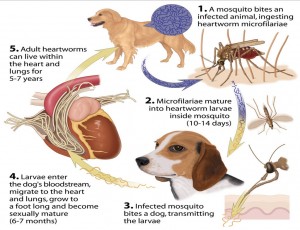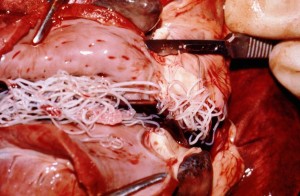 If you knew that giving your dog a tasty, chewy, inexpensive treat every 30 days could prevent a devastating and deadly disease—wouldn’t you give it to him? If that same tasty, chewy treat could kill intestinal parasites—wouldn’t you give it to him? Well, you can! One simple test every year followed by monthly heartworm preventive could save your dog’s life.
If you knew that giving your dog a tasty, chewy, inexpensive treat every 30 days could prevent a devastating and deadly disease—wouldn’t you give it to him? If that same tasty, chewy treat could kill intestinal parasites—wouldn’t you give it to him? Well, you can! One simple test every year followed by monthly heartworm preventive could save your dog’s life.
bite from an infected mosquito. Inside the dog, the worms mature into adults. Their entire life cycle is lived inside the dog. They mate inside and produce offspring. The worms life primarily in the heart, lungs and blood vessels of a heartworm infected dog.
Most heartworm disease in the United States is seen in the southern states along the Gulf coast. The insurgence of dogs being rescued from kill shelters in the south is helping spread the disease in cooler climates of the northern states. When a mosquito bite a heartworm infected dog the mosquito becomes infected with the heartworm offspring called microfilaria. Inside the mosquito, the microfilaria becomes infective larvae. When that mosquito bites another dog, that dog then becomes infected with heartworm and the cycle begins again.
 Heartworm disease is not contagious from one dog to the next. It can only be contracted from an infected mosquito. Adult heartworms look like strands of spaghetti which live inside the dog, which, if left untreated will cause death.
Heartworm disease is not contagious from one dog to the next. It can only be contracted from an infected mosquito. Adult heartworms look like strands of spaghetti which live inside the dog, which, if left untreated will cause death.
In the early stages of heartworm disease, most dogs will not show symptoms. The longer the dog is infected with heartworm, the more severe the symptoms will be. A sedentary dog may not show any symptoms for quite some time while a more active dog will show exhibit signs such as coughing, fatigue and exercise intolerance.
The treatment for heartworm disease is not only painful and toxic, but it is also expensive. A lifetime supply of heartworm preventatives (pictured to the right) would still cost you less money than it would treat your dog for heartworm. Immiticide, one of the drugs used to treat heartworm, is an arsenic-containing drug which is given via a deep muscle injection into the back muscles. Treatment requires multiple visits and hospitalizations, blood work, x-rays and a series of injections.
The best treatment for heartworm is prevention. There are chewable and non-chewable medications and also topical medication applied to the skin. Many of the medications contain products that also prevent and treat roundworms, whipworms, hookworms, and tapeworms.
A blood test is used to test a dog for heartworms. The earliest that heartworm can be detected in a dog’s bloodstream is about 5 months after it has been bitten by an infected mosquito. It is strongly recommended that a dog that tests negative for heartworm be immediately started on a monthly heartworm preventive given year-round for the rest of the dog’s life.
Please test your dogs annually and invest in a lifetime of health and happiness for your precious companion by purchasing and remembering to give her monthly heartworm medication. As always, we are always happy to help you decide which product to choose and discuss heartworm disease with you at any time.

